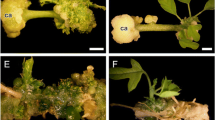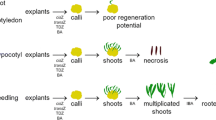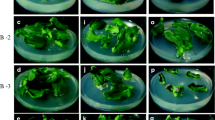Abstract
Plant growth regulator-dependent (PGR-dependent) in vitro shoot organogenesis has been extensively studied in tomato (Lycopersicon esculentum), whereas PGR-independent adventitious shoot organogenesis received marginal attention in L. esculentum and no consideration at all in other Lycopersicon species. In the present study, induction of PGR-independent adventitious shoots was by decapitation of the apex and removal of preexisting shoot meristems of the seedling, and seedling culture on a medium with no PGR supplements. The existence of PGR-independent regeneration-ability was verified in L. esculentum genotypes (high pigment photomorphogenic mutants and wild-type counterparts) and was uncover amongst L. cheesmanii, L. chilense, L. chmielewskii, L. hirsutum, L. parviflorum, L.␣peruvianum and L. pimpinellifolium. Compared to species other than L. esculentum, high pigment photomorphogenic mutants displayed the weakest PGR-independent regeneration-ability. Our results imply that decapitated seedlings cultured on a medium without PGRs can serve as a convenient assay system for genotypic variation in self-controlled, PGR-independent, shoot regeneration-ability in a wide range of Lycopersicon species. Using transverse thin slices of the hypocotyl placed onto a medium supplemented with 0.2 μM zeatin reboside and 0.04 μM IAA, we assessed PGR-mediated shoot regeneration in L. esculentum genotypes. In a given genotype, more plants per seedling were established by PGR-mediated than by PGR-independent regeneration. However, with both modes of organogenesis, only a fraction of shoot buds eventually grew into normal plants, while others developed into abnormal regenerants having no stem. Percentage of stem-deficiency, in a given genotype, was higher in PGR-treated cultures, which indicates that PGRs amplify the formation frequency of imperfect adventitious apical shoot meristems. Unlike L. esculentum, adventitious shoot buds of other Lycopersicon species, induced by wounding seedlings that were not treated with PGRs, rarely formed regenerants lacking a stem.
Similar content being viewed by others
Abbreviations
- IAA:
-
indole-3-acetic acid
- IBA:
-
indole-3-butyric acid
- MES:
-
2-(N-morpholino)ethanesulfonic acid
- PGR:
-
plant growth regulator
- RIM:
-
root induction medium
- SIM:
-
shoot induction medium
- ZR:
-
zeatin riboside
References
Barg R, Pilowsky M, Shabtai S, Carmi N, Szechtman AD, Dedicova B, Salts Y, (1997) The TYLCV-tolerant tomato line MP-1 is characterized by superior transformation competence J. Exp. Bot. 48:1919–1923
Bhatia P, Ashwath N, Senaratna T, Midmore D, (2004) Tissue culture studies of tomato (Lycopersicon esculentum) Plant Cell Tiss. Org. Cult. 78:1–21
Bhatia P, Ashwath N, Midmore D, (2005) Effect of genotype, explant orientation, and wounding on shoot regeneration in tomato In Vitro Cell. Dev. Biol.-Plant 41:457–464
Bino RJ, R-de Vos CH, Lieberman M, Hall RD, Bovy A, Jonker HH, Tikunov Y, Lommen A, Moco S, Levin I, (2005) The light-hyperresponsive high pigment-2dg mutation of tomato: alterations in the fruit metabolome New Phytol. 166:427–438
Budziszewski GJ, Lewis PS, Glover LW, Reineke J, Jones G, Ziemnik LS, Lonowski J, Nyfeler B, Aux G, Zhou Q, McElver J, Patton DA, Martienssen R, Grossniklaus U, Ma H, Law M, Levin JZ, (2001) Arabidopsis genes essential for seedling viability: isolation of insertional mutants and molecular cloning Genetics 159:1765–1778
Bulk RW van den, Loffler HJM, Lindhout WH, Koornneef M, (1990) Somaclonal variation in tomato: effect of explant source and a comparison with chemical mutagenesis Theor. Appl. Gene. 80:817–825
Compton ME, Veilleux RE, (1991) Shoot, root and flower morphogenesis on tomato inflorescence explants Plant Cell Tiss. Org. Cult. 24:223–231
El-Bakry AA, (2002) Effect of genotype, growth regulators, carbon source, and pH on shoot induction and plant regeneration in tomato, In vitro Cell Devel. Biol.-Plant 38:501–507
Faria RT de, Destro D, Bespalhok JC, Illg RD, (2002) Introgression of in vitro regeneration capability of Lycopersicon pimpinellifolium Mill. into recalcitrant tomato cultivars Euphytica 124:59–63
Gamborg OL, Miller RA, Ojima K, (1968) Nutrient requirement of suspension cultures of soybean root cells Exp. Cell Res. 50:151–158
Howell SH, Lall S, Che P, (2003) Cytokinins, shoot development Trends Plant Sci. 8:453–459
KaurSawhney R, Applewhite PB, Galston AW, (1996) Formation in vitro of ripe tomato fruits from thin layer explants of flower pedicels Plant Growth Reg. 18:191–199
Keddie JS, Carroll BJ, Thomas CM, Reyes MEC, Klimyuk V, Holtan H, Gruissem W, Jones JDG, (1998) Transposon tagging of the Defective embryo and meristems gene of tomato Plant Cell 10:877–887
Koornneef M, Bade J, Hanhart C, Horsman K, Schel J, Soppe W, Verkerk R, Zabel P, (1993) Characterization and mapping of a gene controlling shoot regeneration in tomato Plant J. 3:131–141
Levin I, Frankel P, Gilboa N, Tanny S, Lalazar A, (2003) The tomato dark green mutation is a novel allele of the tomato homolog of the DEETIOLATED1 gene Theor. Appl. Genet. 106:454–460
Lieberman M, Segev O, Gilboa N, Lalazar A, Levin I, (2004) The tomato homolog of the gene encoding UV-damaged DNA binding protein 1 (DDB1) underlined as the gene that causes the high pigment-1 mutant phenotype Theo. Appl. Genet. 108:1574–1581
Mayer KFX, Schoof H, Haecker A, Lenhard M, Jürgens G, Laux T, (1998) Role of WUSCHEL in regulating stem cell fate in the Arabidopsis shoot meristem Cell 95:805–815
Murashige T, Skoog F, (1962) A revised medium for rapid growth and bioassays with tobacco tissue cultures Physiol. Plant. 15:473–497
Nickle TC, Yeung EC, (1993) Failure to establish a functional shoot meristem may be a cause of conversion failure in somatic embryos of Dactus carota (Apiaceae), Amer J. Bot. 80:128–1291
Padmanabhan K, Cantliffe DJ, Harrell RC, McConnell DB, (1998) A comparison of shoot-forming and non-shoot-forming somatic embryos of sweet potato [Ipomea batatas (L.) Lam.] using computer vision histological analysis Plant Cell Rep. 17:685–692
Peres LEP, Morgante PG, Vecchi C, Kraus JE & van Sluys MA, (2001) Shoot regeneration capacity from roots and transgenic hairy roots of tomato cultivars and wild related species Plant Cell Tiss. Org. Cult. 65:37–44
Pilu R, Consonni G, Busti E, MacCabe AP, Giulini A, Dolfini S, Gavazzi G, (2002) Mutations in two independent genes lead to suppression of the shoot apical meristem in maize Plant Physiol. 128:502–511
Pozueta-Romero J., Houlné G, Cañas L, Schantz R, Chamarro J, (2001) Enhanced regeneration of tomato and pepper seedling explants for Agrobacterium-mediated transformation Plant Cell Tiss. Org. Cult. 67:173–180
Pratta G, Cánepa LN, Zorzoli R, Picardi LA, (2003) Diallel analysis of in vitro culture traits in the genus Lycopersicon HortScience 38:110–112
Radin DN, Eisenback JD, (1991) Infection of cultured thin cell layer roots of Lycopersicon esculentum by Meloidogyne incongnita J. Nematology 23:441–445
Ramage CM, Williams RR, (2004) Cytokinin-induced abnormal shoot organogenesis is associated with elevated Knotted 1-type homeobox gene expression in tobacco Plant Cell Rep. 22:919–924
Rupp HM, Frank M, Werner T, Strnad M, Schmülling T, (1999) Increased steady state mRNA levels of the STM and KNAT1 homeobox genes in cytokinin overproducing Arabidopsis thaliana indicate a role for cytokinins in the shoot apical meristem Plant J. 18:557–563
Satoh N, Hong SK, Nishimura A, Matsuoka M, Kitano H, Nagato Y, (1999) Initiation of shoot apical meristem in rice: characterization of four SHOOTLESS genes Development 126:3629–3636
Sigareva M, Spivey R, Willits MG, Kramer CM, Chang YF, (2004) An efficient mannose selection protocol for tomato that has no adverse effect on the ploidy level of transgenic plants Plant Cell Rep 23:236–245
Steinitz B, Küsek M, Tabib Y, Paran I, Zelcer A, (2003) Pepper (Capsicum annuum L.) regenerants obtained by direct somatic embryogenesis fail to develop a shoot In Vitro Cell. Dev. Biol.-Plant 39:296–303
Stommel JR, Sinden SL, (1991) Genotypic differences in shoot-forming capacity of cultured leaf explants of Lycopersicon hirsutum HortScience 26:1317–1320
Toponyanon N, Awpawan R, Debergh PC, (1999) Bushiness in gerbera jamesonii: abnormal shoot development during micropropagation J. Hortic. Sci. Biotechnol. 74:75–679
Acknowledgements
Contribution from the Agricultural Research Organization, The Volcani Center, Bet Dagan, Israel, no. 131/2004. This research was supported in part by Research Grant Award No. IS-3441–03 from BARD, The United States–Israel Binational Agricultural Research and Development Fund. We thank Mrs. N. Gilboa for technical assistance
Author information
Authors and Affiliations
Corresponding author
Rights and permissions
About this article
Cite this article
Steinitz, B., Amitay, A., Gaba, V. et al. A simple plant regeneration-ability assay in a range of Lycopersicon species . Plant Cell Tiss Organ Cult 84, 269–278 (2006). https://doi.org/10.1007/s11240-005-9032-8
Received:
Accepted:
Published:
Issue Date:
DOI: https://doi.org/10.1007/s11240-005-9032-8




